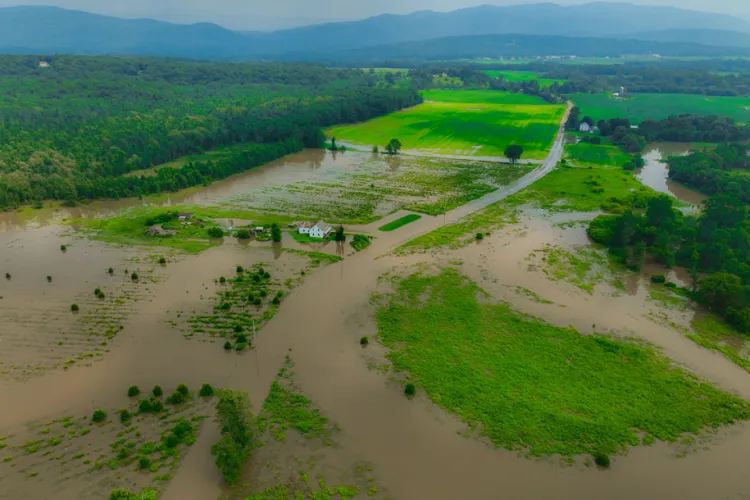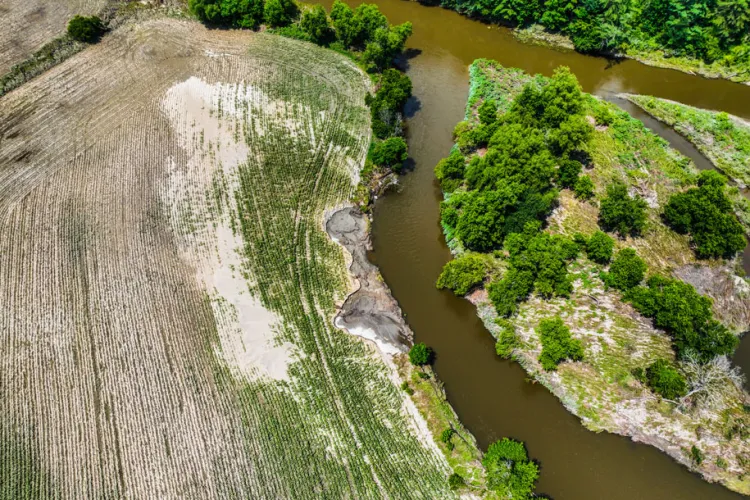Christa Alexander inks the names of vegetables on popsicle sticks inside a toasty hoophouse at Jericho Settlers Farm. Behind her rests a bag of potting soil the size of a small vehicle and a tray of perky pea shoots. The sky is postcard blue, and yet, last summer’s flooding looms in the background of a conversation about resilience in the face of climate change.
“I have a lot of ideas,” Alexander says amidst rows of tender green tomato and squash plants.
She grew up in Jericho.
“Right here,” Alexander says, pointing to the ground. “But this was not a working farm when I grew up.”
She and her husband, Mark Fasching, began farming the land in 2002. But things have changed. The huge snowstorms and deep winter freezes of her childhood are gone.
“Pest and disease don’t always die off in the winter because it’s so warm,” she says. “And then there is the extreme weather events.”
They manage the shifting landscape by spreading their risk. They grow a diverse set of crops, split their markets between local restaurants and grocers, and run a Community Supported Agriculture program. They also farm year-round, and they don’t farm in one place.
“That has saved us time and time again,” Alexander says.
Last July, Jericho Settlers Farm’s crops of carrot and beets—hundreds of thousands of dollars’ worth—were underwater in a field in Richmond after record rainfall pelted the state in the worst flooding event since the Great Vermont Flood of 1927. The day after, farm workers planted salad greens in the Jericho hoophouses. There was no time to wallow in what was lost.
Meeting the Needs of Farmers

Heavy rains in early July dumped nearly two months of water in two days along the spine of the Green Mountains, resulting in catastophic flooding across much of the state, including this site in Middlebury, Vermont. Extreme weather events in 2023 caused roughly $69,000,000 in losses to Vermont’s food and agricultural sector last year, according to the Vermont Agriculture Recovery Task Force.
Extreme weather events caused roughly $69,000,000 in losses to Vermont’s food and agricultural sector last year, according to the Vermont Agriculture Recovery Task Force. And while donations poured into local charities and the state created financial assistance programs, the $6,000,000 amassed for agriculture statewide simply could not meet the need.
“There is a massive gap in damage versus what we were able to provide, and it is one of those things that is very difficult to close that gap in real-time,” said Roy Beckford, director of University of Vermont Extension and co-chair of the task force when it released its assessment in February.
There is a downstream effect in productivity too.
“It affects bottom line, and all of those issues have a negative impact on the follow-up year,” Beckford said.
However, immediate cash flow from grants administered by groups such as the Department of Economic Development’s Business Emergency Gap Assistance Program are what kept Jericho Settlers Farm afloat after the flood. Nine months later, the farm has received just one $1,800 check for federal crop insurance, Alexander says. “But I lost $350,000 worth of crops. ... That doesn’t keep a business going.”
With much of their summer harvests underwater, Alexander worried the farm could lose its staff, too—just when they needed them most. “I also couldn’t do that because I had to produce. We still had time to get some stuff in the ground and save part of the season.”
This is the type of scenario the Vermont Agriculture Recovery Task Force is trying to help more farmers avoid when disaster strikes. The task force, co-chaired by Beckford and Nicole Dubuque, chief operating officer for Vermont Agency of Agriculture, Food & Markets, examined the scale of damage from both the July flooding and a late frost in May 2023 that decimated fruit tree and berry harvests, and identified gaps in recovery efforts. The aim is to understand both how the state responded to these emergencies and how to prepare and recover from similar disasters in the future.
Among the most alarming findings was how vulnerable many Vermont farms are to losing their livelihoods. Surveys of Vermont growers revealed that 70 percent did not have crop or livestock insurance, and more than half said they would be operating in the red in 2024. But purchasing crop insurance is not a simple fix. Many Vermont farms don’t have crop insurance for a reason—it’s not built for them.
The premiums are often much higher than the payouts would be because most of the federal aid is not designed for small, diversified farms that are more common in Vermont, explains Dubuque. “They are really designed for larger operations like what you see in the Midwest … and they don’t cover value-added products. For example, if a vineyard has crop insurance, it will cover the cost of the grapes that you lost but you won’t get any returns for the wine you cannot make.”
Other problems the group surfaced include loopholes that prevented farmers from receiving payouts for feed they were unable to harvest due to the flood.
“It takes away the incentive to grow your own feed,” Dubuque says.
She is hoping policy changes to the Farm Bill and crop insurance programs may remedy some of the disconnect. “I’d love to see programs adapt and evolve faster,” she says, “but it’s important that these problems are on the radar.”

The Vermont Agriculture Recovery Task Force found that about 70 percent of farms surveyed did not have crop insurance and more than half reported they would operate in the red in 2024.
Death by a Thousand Cuts
Moving forward after an extreme weather event often involves filling out paperwork (sometimes the same information repeatedly) and waiting for damage assessments before one can begin repairing what was lost.
“It becomes death by a thousand cuts for the farmer,” says UVM Extension vegetable and berry specialist Vern Grubinger.
And for many farmers, it’s not just the loss of a crop. It’s the equipment carried away and the infrastructure damaged, and the need to still meet payroll. What often gets people through is support from friends and volunteers in their communities, he says. “It’s what happened after Irene.”
And it’s what happened in flooded downtowns and farm fields last July. Neighbors mucking out neighbors, people showing up with excavators and getting to work.
“That is the special thing that Vermont has,” Grubinger says. “But it’s a lot to ask, and some of those farms will be in debt hundreds of thousands of dollars still moving forward.”
Last summer, Grubinger and other Extension members provided free soil tests to 166 sites across the state, including Jericho Settlers Farm, and joined efforts to help farmers get back on their feet by joining review boards for groups such as the Northeast Organic Farming Association and the Vermont Community Fund, both of which established emergency relief funds for farmers.
“UVM did a good job steering people to these financial resources,” Grubinger says.
The task force outlined several recommendations for improving coordination and increasing the resilience of growers such as investing in grant opportunities for farmers; establishing a public-private council to expedite emergency funding; and advocating for changes in the federal crop insurance programs. They will review findings from a new survey open through August to collect data from farmers on the losses covered by insurance or relief programs.
“We continue to work together to close these gaps,” Dubuque says. “Some things UVM Extension hears on the ground is different from [us]. Farmers are really busy and don’t have time to drive to the statehouse to speak their peace.”
Imagining a More Resilient Food System
These days Christa Alexander thinks a lot about the future of farming in Vermont.
Growing up, her family grew much of what they ate, and she thinks more people should be able to consume fresh, local produce. While sorting popsicle sticks, Alexander muses about what it means to be resilient and how to help farms produce year-round and avoid catastrophe from extreme events. She is thinking about community resilience—how to build a local food system and scale it.
“How do we feed more people efficiently?,” she asks. “Because not everyone can buy a CSA or buy retail at the farmer’s market or farm stand. How as a society do we support that continuation and resilience of the food system without burdening just the growers to take on all of that risk? When we talk about big picture resilience, if we really want to feed people, then small and medium sized farms need to scale.”
Picture buying carrots from the grocery store. Now imagine their journey from the farm to your shopping cart. Someone pulled it from the ground and washed the soil gathered in the grooves. The tips of the greens, once coated with dirt and dust and dew, may have been removed before being banded or bagged. This is called value-added processing. And this is what Alexander is focused on.
“In New England, we don’t have a lot of processing facilities,” she says.
Alexander would love to be able to ship her number two carrots—the cored down rejects known fondly as baby carrots—to a site where they could be washed, stored, packed and then shipped across New England. But that is an infrastructure investment she alone can’t make.
“I have 40 acres I don’t plant every year,” she explains. “I use them in rotation. But I could just plant 10 of those and produce 400,000 more pounds of carrots. I could do it with the equipment I have. I just couldn’t wash them and pack them and ship them out. And there are a lot of farms like me that could do that too. They just need someone to deal with the other end of it.”
Alexander knows building a resilient food system is not her problem to solve. Just as climate change is not a problem that she alone can solve. But she knows it is something we need to think about.
“From a resilient standpoint, when energy becomes an issue and water becomes an issue California is going to be in tough shape,” Alexander says. “Some of our other major producing areas are going to be hurting for water. We probably won’t be. We will probably have too much.”
UVM researchers across disciplines assisted Vermont communities affected by the July 2023 floods. The Spatial Analysis Lab deployed its Unoccupied Aerial Systems Team members to document the extent of flooding and created a rapid drinking water assessment for the Vermont Department of Health. Kelly Hamshaw routinely works with manufactured home communities (MHCs) in planning and recovery efforts using a climate justice lens. Her latest investigation is one of six UVM projects funded after last year’s flooding to better understand the state’s recovery and response.
[Editor's Note: This story was published just prior to the rains of July 10-11, 2024 that caused more catastrophic flooding across Vermont. The UVM faculty and staff mentioned in this piece and in its related story are continuing their work throughout the state.]

